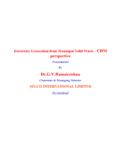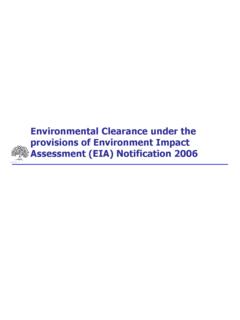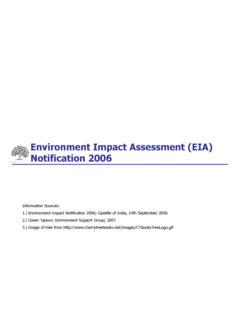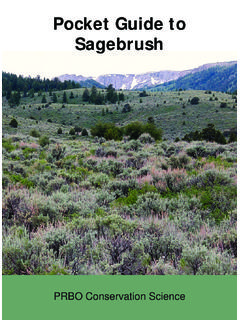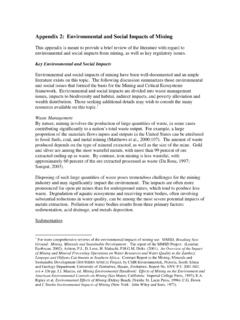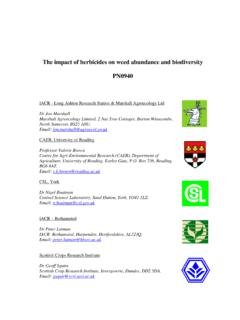Transcription of Natural Resource Management - EPCO
1 Natural Resource Management Block 6 Unit 11 Part-IISyllabus State of resources Managing our Natural resources Water Soil and land Resource Energy sources Minerals the underground wealth Social and Political responsibilities for environmental conservation and protection environmental education, significant political and social movementsNRM Definition Natural Resource managementrefers to the Management ofnatural resourcessuch asland,water,soil,plantsandanimals, with a particular focus on how Management affects thequality of lifefor both present and future generations (stewardship).
2 Natural Resource Management deals with managing the way in which people and naturallandscapesinteract. It brings together land use planning, water Management ,biodiversity conservation, and the future sustainability of industries It recognizes that people and their livelihoods rely on the health and productivity of our landscapes, and their actions as stewards of the land play a critical role in maintaining this health and productivity. Natural Resource Management is also congruent with the concept ofsustainable development. Natural Resource Management specifically focuses on a scientific and technical understanding of resources andecologyand the life-supporting capacity of those resources.
3 Environmental managementis also similar to Natural Resource Management .History Theresource conservationmovement in the 20th century recognized that conservation strategies had not been effective in halting the decline of Natural resources. A more integrated approach was implemented recognizing the intertwined social, cultural, economic and political aspects of Resource Management . A more holistic, national and even global form evolved, from theBrundtlandCommissionand the advocacy ofsustainable & Ownership Regime NRM approaches can be categorisedaccording to the kind and right ofstakeholders, Natural resources: State Property Regime Ownership and control over the use of resources is in hands of the state.
4 Individuals or groups may be able to make use of the resources, but only at the permission of the state. National forest, National parks and military reservations are some examples. Private Property Regime Any property owned by a defined individual or corporate entity. Both the benefit and duties to the resources fall to the owner(s). Private land is the most common example. Common Property Regimes It is a private property of a group. The group may vary in size, nature and internal structure indigenous tribe, neighboursof village. Some examples of common property are community forests, grasslands andwater resources.
5 Non-property Regimes (open access) There is no definite owner of these properties. Each potential user has equal ability to use it as they wish. These areas are the most exploited. It is said that "Everybody's property is nobody s property". An example is a lake fishery. This ownership regime is often linked to thetragedy of the commons. Hybrid Regimes Many ownership regimes governing Natural resources will contain parts of more than one of the regimes described above, so Natural Resource managers need to consider the impact of hybrid regimes.
6 Management approaches NRM issues are complex as they involve the ecological cycles, hydrological cycles, climate, human beings, animals, plants and geography etc. All these are dynamic and inter-related. change in one of them may have far reaching and/or long term impacts may be irreversible. In addition to the Natural systems, Natural Resource Management also has to manage various stakeholders and their interests, policies, politics, geographical boundaries, economic implications and the list goes on. It is very difficult to satisfy all aspects at the same time.
7 This results in conflicting situations. United Nations Conference for the Environment and Development (UNCED) -Rio de Janeiro in 1992 The various approaches include: Top-down or Command and control Bottom-Up (regional or community based NRM) Adaptivemanagement Precautionary approach Integrated approach (INRM)Community Based NRM CBNRM combines conservation with the generation of economic benefits for rural communities. Capacity ofindigenouscommunities to conserve NR acknowledged Governance is seen as a key consideration for delivering CBNRM The three key assumptions : locals are better placed to conserve Natural resources, people will conserve a Resource only if benefits exceed the costs of conservation, and people will conserve a Resource that is linked directly to their quality of life.
8 The UN advocates CBNRM in the CBD and the Convention to Combat Desertification. A problem of community based NRM is the difficulty of reconciling and harmonizing the objectives of socioeconomic development, biodiversity protection and sustainable Resource utilization. Understanding power relations crucial to success of CBNRM CBNRM raised new challenges, as concepts of community, territory, conservation, and indigenous are worked into politically varied plans and programsIntegrated Natural Resource Management (INRM)Definition A process of managing Natural resources in a systematic way, which includes multiple aspects of Natural Resource use (biophysical, socio-political, and economic) meet production goals of producers and other direct users ( , food security, profitability, risk aversion)
9 As well as goals of the wider community ( , poverty alleviation, welfare of future generations, environmental conservation). It focuses on sustainability and at the same time tries to incorporate all possible stakeholders from the planning level itself, reducing possible future conflicts. The conceptual basis of INRM has evolved in recent years through the convergence of research in diverse areas such as sustainable land use, participatory planning, integrated watershed Management , and adaptive Management . INRM is being used extensively and been successful in regional and community based Natural Management .
10 Frameworks and modelling There are various frameworks and computer models developed to assist Natural Resource Information Systems (GIS) GISis a powerful analytical tool as it is capable of overlaying datasets to identify links. A bush regeneration scheme can be informed by the overlay of rainfall, cleared land and erosion. These are limited by the potential for subjective input and data Resources Audit Framework To assist the establishment of a performance audit role in the governance of regional Natural Resource Management . This audit framework builds from other established audit methodologies, includingperformance audit,environmental auditandinternal audit.

